Effective Workplace Culture Analysis and Recommendations Report
VerifiedAdded on 2023/01/11
|11
|2634
|45
Report
AI Summary
This report analyzes the concept of effective workplace culture within a healthcare context. It utilizes the Effective Workplace Culture Framework, encompassing enabling factors, essential attributes, and consequences, to examine key themes such as the healthcare approach, stability among services, and the creation of a positive and hygienic environment. The analysis delves into how person-centered care, efficient service delivery, and environmental benefits contribute to a thriving healthcare culture. Recommendations for improvements include smart personnel management, fostering a person-centered approach, and enabling staff engagement. The report highlights the importance of hygiene, positive environments, and patient satisfaction, emphasizing the need for continuous improvement in healthcare practices to enhance patient outcomes and overall organizational performance. The report is based on the student's analysis and recommendations based on the assignment brief provided.
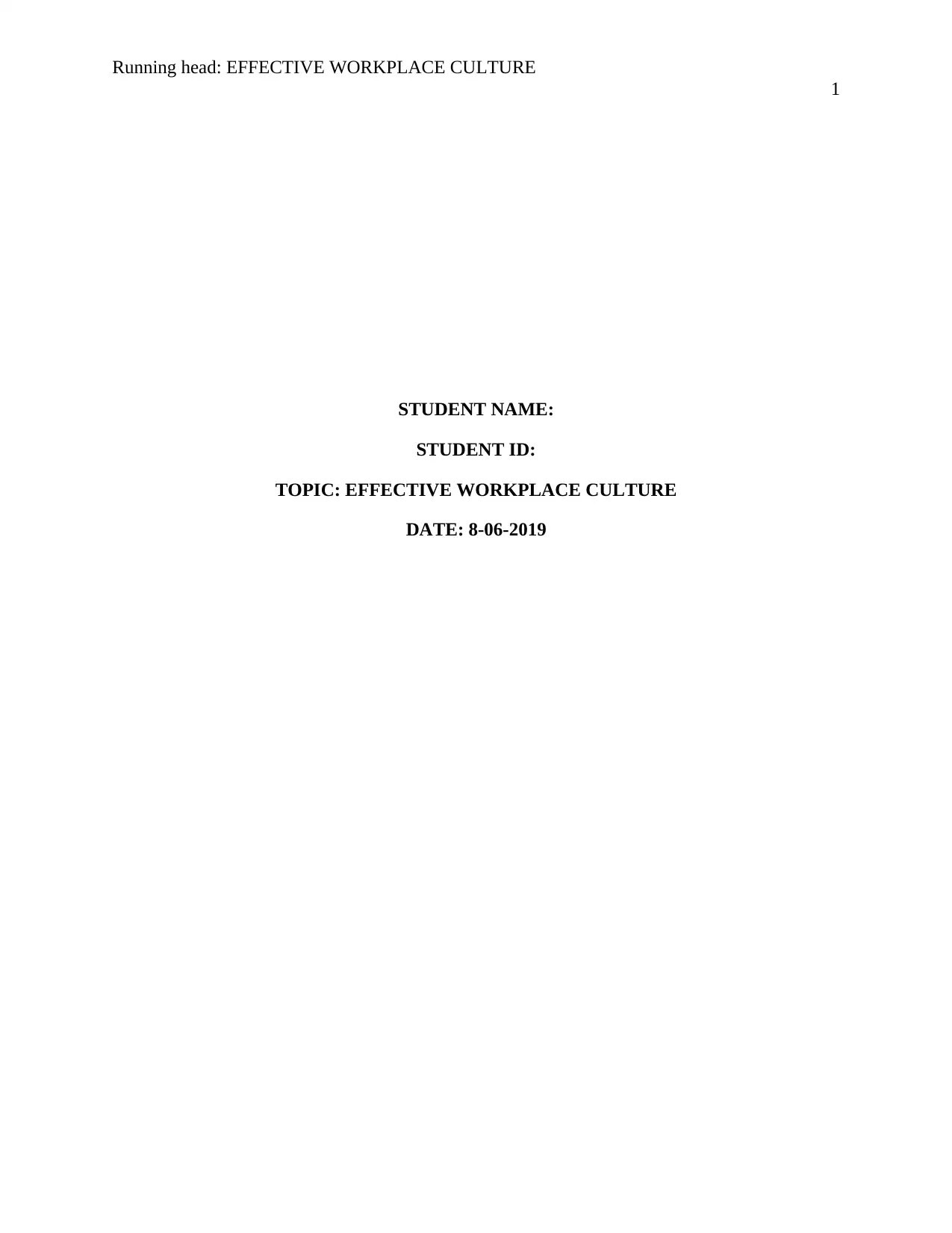
Running head: EFFECTIVE WORKPLACE CULTURE
1
STUDENT NAME:
STUDENT ID:
TOPIC: EFFECTIVE WORKPLACE CULTURE
DATE: 8-06-2019
1
STUDENT NAME:
STUDENT ID:
TOPIC: EFFECTIVE WORKPLACE CULTURE
DATE: 8-06-2019
Paraphrase This Document
Need a fresh take? Get an instant paraphrase of this document with our AI Paraphraser
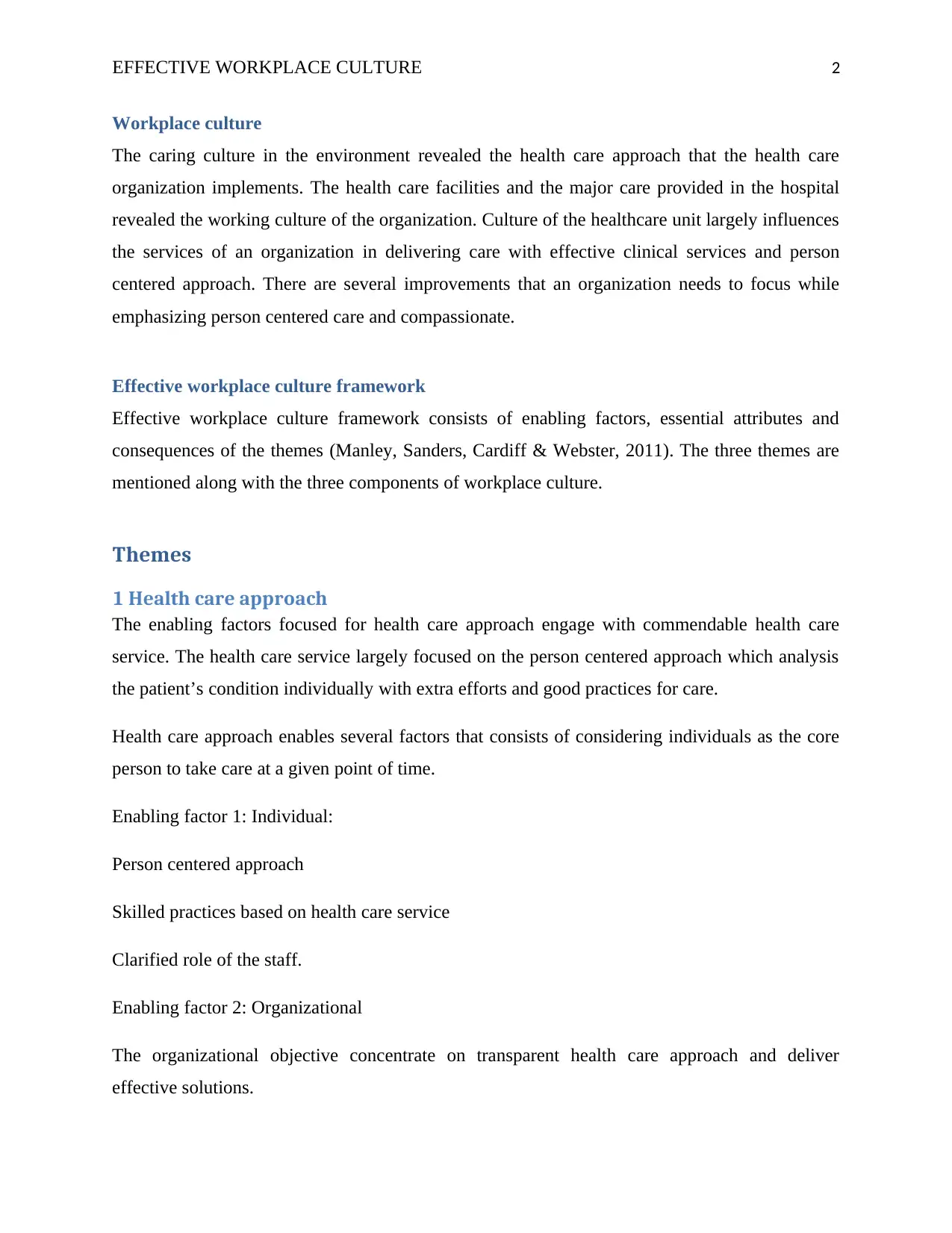
EFFECTIVE WORKPLACE CULTURE 2
Workplace culture
The caring culture in the environment revealed the health care approach that the health care
organization implements. The health care facilities and the major care provided in the hospital
revealed the working culture of the organization. Culture of the healthcare unit largely influences
the services of an organization in delivering care with effective clinical services and person
centered approach. There are several improvements that an organization needs to focus while
emphasizing person centered care and compassionate.
Effective workplace culture framework
Effective workplace culture framework consists of enabling factors, essential attributes and
consequences of the themes (Manley, Sanders, Cardiff & Webster, 2011). The three themes are
mentioned along with the three components of workplace culture.
Themes
1 Health care approach
The enabling factors focused for health care approach engage with commendable health care
service. The health care service largely focused on the person centered approach which analysis
the patient’s condition individually with extra efforts and good practices for care.
Health care approach enables several factors that consists of considering individuals as the core
person to take care at a given point of time.
Enabling factor 1: Individual:
Person centered approach
Skilled practices based on health care service
Clarified role of the staff.
Enabling factor 2: Organizational
The organizational objective concentrate on transparent health care approach and deliver
effective solutions.
Workplace culture
The caring culture in the environment revealed the health care approach that the health care
organization implements. The health care facilities and the major care provided in the hospital
revealed the working culture of the organization. Culture of the healthcare unit largely influences
the services of an organization in delivering care with effective clinical services and person
centered approach. There are several improvements that an organization needs to focus while
emphasizing person centered care and compassionate.
Effective workplace culture framework
Effective workplace culture framework consists of enabling factors, essential attributes and
consequences of the themes (Manley, Sanders, Cardiff & Webster, 2011). The three themes are
mentioned along with the three components of workplace culture.
Themes
1 Health care approach
The enabling factors focused for health care approach engage with commendable health care
service. The health care service largely focused on the person centered approach which analysis
the patient’s condition individually with extra efforts and good practices for care.
Health care approach enables several factors that consists of considering individuals as the core
person to take care at a given point of time.
Enabling factor 1: Individual:
Person centered approach
Skilled practices based on health care service
Clarified role of the staff.
Enabling factor 2: Organizational
The organizational objective concentrate on transparent health care approach and deliver
effective solutions.
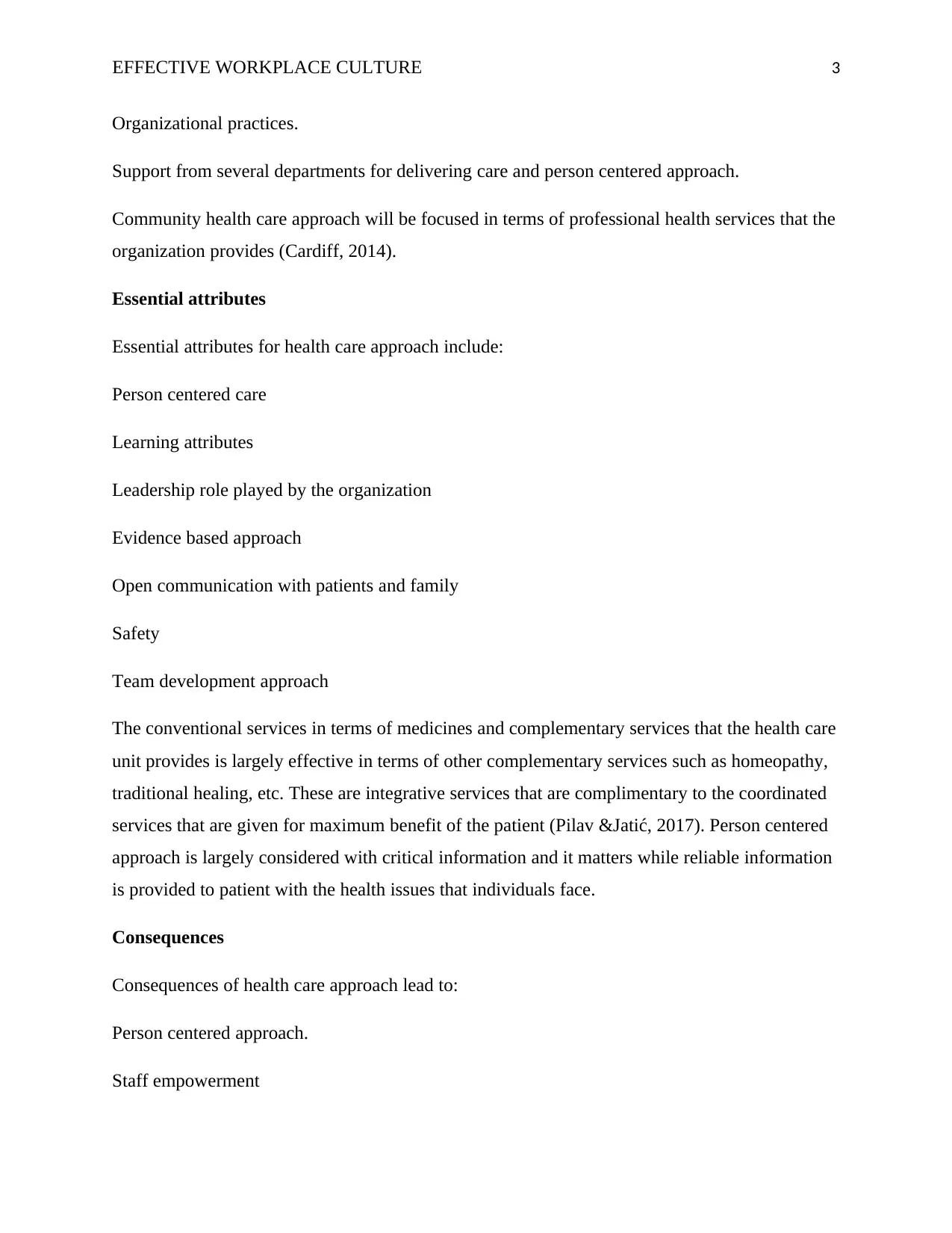
EFFECTIVE WORKPLACE CULTURE 3
Organizational practices.
Support from several departments for delivering care and person centered approach.
Community health care approach will be focused in terms of professional health services that the
organization provides (Cardiff, 2014).
Essential attributes
Essential attributes for health care approach include:
Person centered care
Learning attributes
Leadership role played by the organization
Evidence based approach
Open communication with patients and family
Safety
Team development approach
The conventional services in terms of medicines and complementary services that the health care
unit provides is largely effective in terms of other complementary services such as homeopathy,
traditional healing, etc. These are integrative services that are complimentary to the coordinated
services that are given for maximum benefit of the patient (Pilav &Jatić, 2017). Person centered
approach is largely considered with critical information and it matters while reliable information
is provided to patient with the health issues that individuals face.
Consequences
Consequences of health care approach lead to:
Person centered approach.
Staff empowerment
Organizational practices.
Support from several departments for delivering care and person centered approach.
Community health care approach will be focused in terms of professional health services that the
organization provides (Cardiff, 2014).
Essential attributes
Essential attributes for health care approach include:
Person centered care
Learning attributes
Leadership role played by the organization
Evidence based approach
Open communication with patients and family
Safety
Team development approach
The conventional services in terms of medicines and complementary services that the health care
unit provides is largely effective in terms of other complementary services such as homeopathy,
traditional healing, etc. These are integrative services that are complimentary to the coordinated
services that are given for maximum benefit of the patient (Pilav &Jatić, 2017). Person centered
approach is largely considered with critical information and it matters while reliable information
is provided to patient with the health issues that individuals face.
Consequences
Consequences of health care approach lead to:
Person centered approach.
Staff empowerment
⊘ This is a preview!⊘
Do you want full access?
Subscribe today to unlock all pages.

Trusted by 1+ million students worldwide
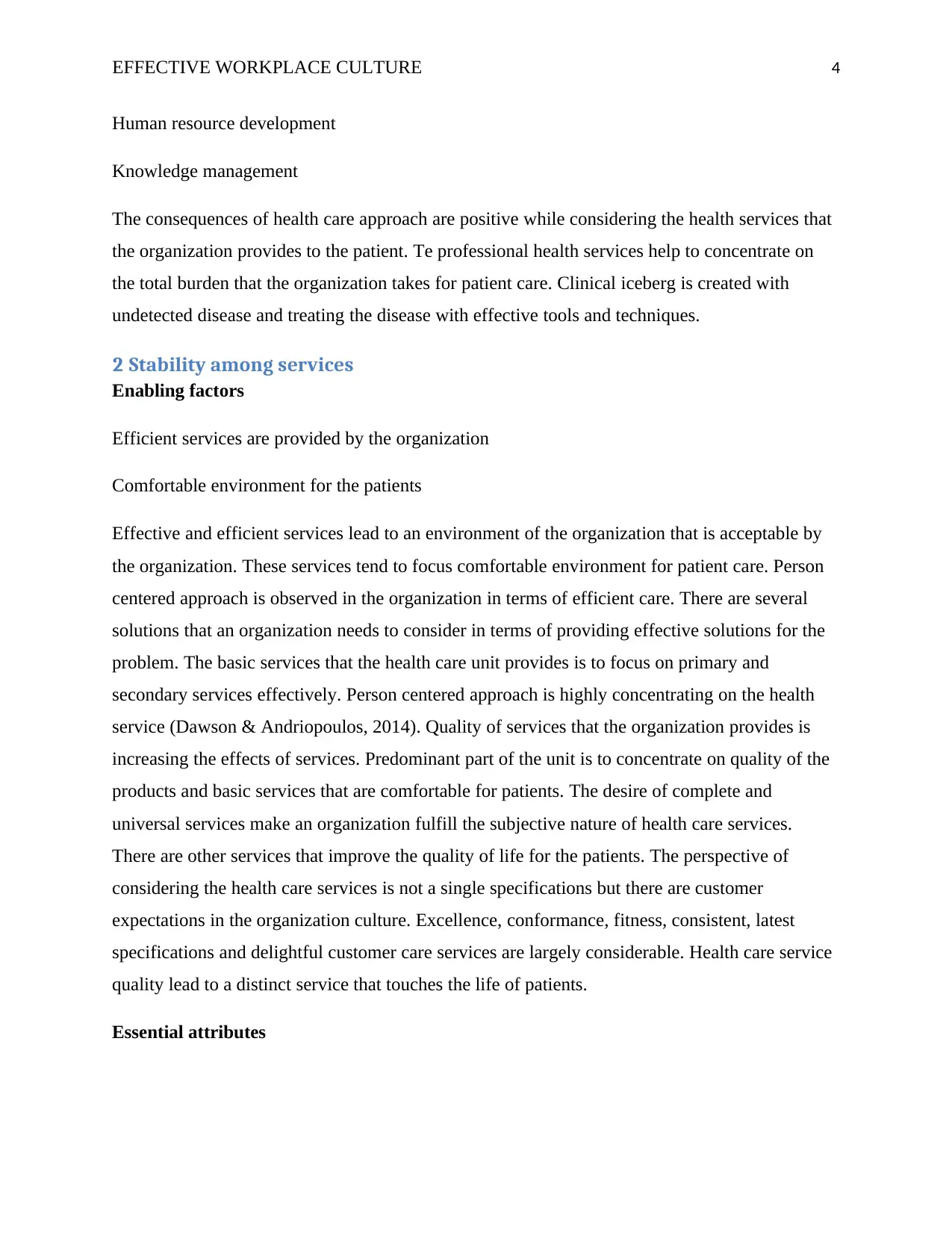
EFFECTIVE WORKPLACE CULTURE 4
Human resource development
Knowledge management
The consequences of health care approach are positive while considering the health services that
the organization provides to the patient. Te professional health services help to concentrate on
the total burden that the organization takes for patient care. Clinical iceberg is created with
undetected disease and treating the disease with effective tools and techniques.
2 Stability among services
Enabling factors
Efficient services are provided by the organization
Comfortable environment for the patients
Effective and efficient services lead to an environment of the organization that is acceptable by
the organization. These services tend to focus comfortable environment for patient care. Person
centered approach is observed in the organization in terms of efficient care. There are several
solutions that an organization needs to consider in terms of providing effective solutions for the
problem. The basic services that the health care unit provides is to focus on primary and
secondary services effectively. Person centered approach is highly concentrating on the health
service (Dawson & Andriopoulos, 2014). Quality of services that the organization provides is
increasing the effects of services. Predominant part of the unit is to concentrate on quality of the
products and basic services that are comfortable for patients. The desire of complete and
universal services make an organization fulfill the subjective nature of health care services.
There are other services that improve the quality of life for the patients. The perspective of
considering the health care services is not a single specifications but there are customer
expectations in the organization culture. Excellence, conformance, fitness, consistent, latest
specifications and delightful customer care services are largely considerable. Health care service
quality lead to a distinct service that touches the life of patients.
Essential attributes
Human resource development
Knowledge management
The consequences of health care approach are positive while considering the health services that
the organization provides to the patient. Te professional health services help to concentrate on
the total burden that the organization takes for patient care. Clinical iceberg is created with
undetected disease and treating the disease with effective tools and techniques.
2 Stability among services
Enabling factors
Efficient services are provided by the organization
Comfortable environment for the patients
Effective and efficient services lead to an environment of the organization that is acceptable by
the organization. These services tend to focus comfortable environment for patient care. Person
centered approach is observed in the organization in terms of efficient care. There are several
solutions that an organization needs to consider in terms of providing effective solutions for the
problem. The basic services that the health care unit provides is to focus on primary and
secondary services effectively. Person centered approach is highly concentrating on the health
service (Dawson & Andriopoulos, 2014). Quality of services that the organization provides is
increasing the effects of services. Predominant part of the unit is to concentrate on quality of the
products and basic services that are comfortable for patients. The desire of complete and
universal services make an organization fulfill the subjective nature of health care services.
There are other services that improve the quality of life for the patients. The perspective of
considering the health care services is not a single specifications but there are customer
expectations in the organization culture. Excellence, conformance, fitness, consistent, latest
specifications and delightful customer care services are largely considerable. Health care service
quality lead to a distinct service that touches the life of patients.
Essential attributes
Paraphrase This Document
Need a fresh take? Get an instant paraphrase of this document with our AI Paraphraser
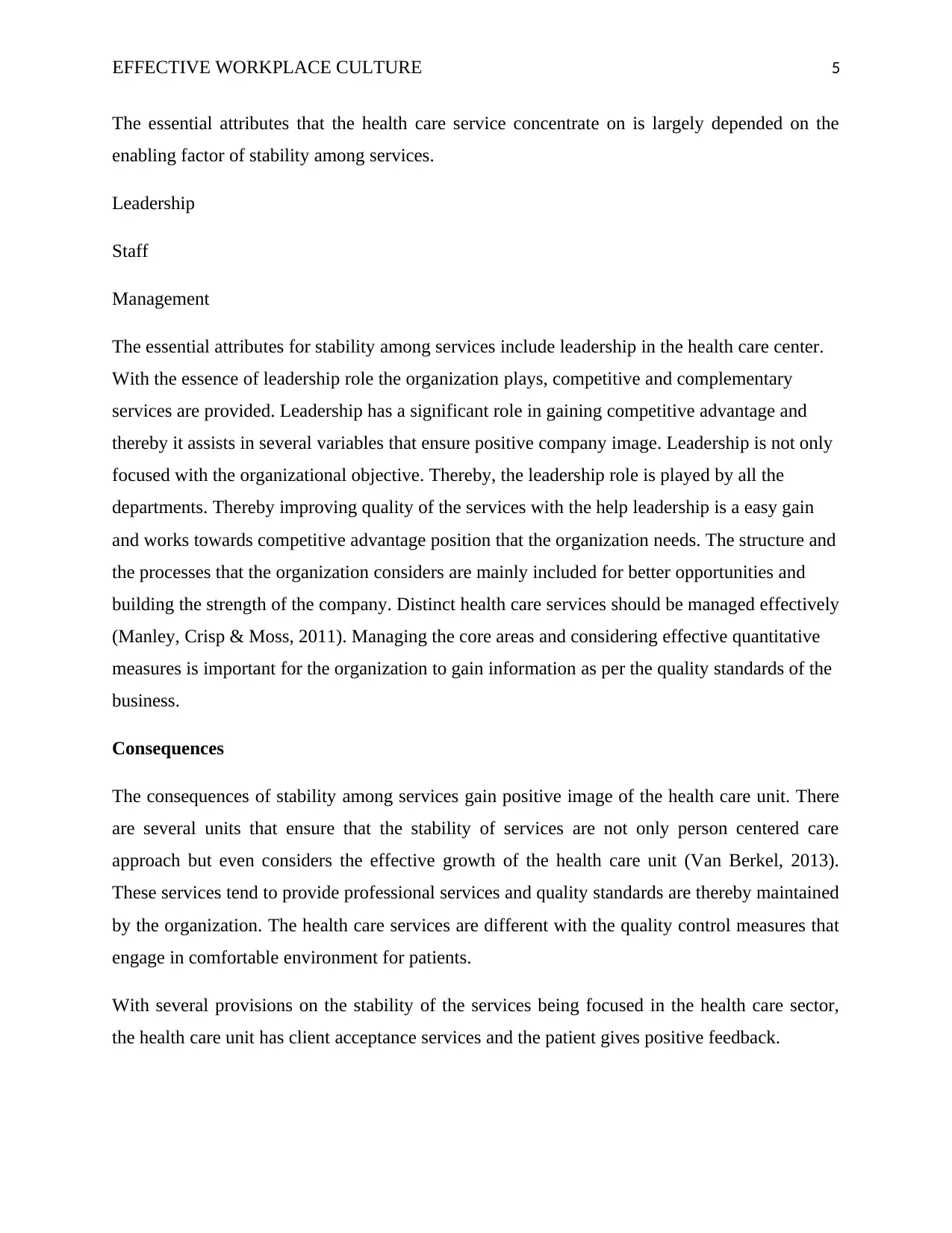
EFFECTIVE WORKPLACE CULTURE 5
The essential attributes that the health care service concentrate on is largely depended on the
enabling factor of stability among services.
Leadership
Staff
Management
The essential attributes for stability among services include leadership in the health care center.
With the essence of leadership role the organization plays, competitive and complementary
services are provided. Leadership has a significant role in gaining competitive advantage and
thereby it assists in several variables that ensure positive company image. Leadership is not only
focused with the organizational objective. Thereby, the leadership role is played by all the
departments. Thereby improving quality of the services with the help leadership is a easy gain
and works towards competitive advantage position that the organization needs. The structure and
the processes that the organization considers are mainly included for better opportunities and
building the strength of the company. Distinct health care services should be managed effectively
(Manley, Crisp & Moss, 2011). Managing the core areas and considering effective quantitative
measures is important for the organization to gain information as per the quality standards of the
business.
Consequences
The consequences of stability among services gain positive image of the health care unit. There
are several units that ensure that the stability of services are not only person centered care
approach but even considers the effective growth of the health care unit (Van Berkel, 2013).
These services tend to provide professional services and quality standards are thereby maintained
by the organization. The health care services are different with the quality control measures that
engage in comfortable environment for patients.
With several provisions on the stability of the services being focused in the health care sector,
the health care unit has client acceptance services and the patient gives positive feedback.
The essential attributes that the health care service concentrate on is largely depended on the
enabling factor of stability among services.
Leadership
Staff
Management
The essential attributes for stability among services include leadership in the health care center.
With the essence of leadership role the organization plays, competitive and complementary
services are provided. Leadership has a significant role in gaining competitive advantage and
thereby it assists in several variables that ensure positive company image. Leadership is not only
focused with the organizational objective. Thereby, the leadership role is played by all the
departments. Thereby improving quality of the services with the help leadership is a easy gain
and works towards competitive advantage position that the organization needs. The structure and
the processes that the organization considers are mainly included for better opportunities and
building the strength of the company. Distinct health care services should be managed effectively
(Manley, Crisp & Moss, 2011). Managing the core areas and considering effective quantitative
measures is important for the organization to gain information as per the quality standards of the
business.
Consequences
The consequences of stability among services gain positive image of the health care unit. There
are several units that ensure that the stability of services are not only person centered care
approach but even considers the effective growth of the health care unit (Van Berkel, 2013).
These services tend to provide professional services and quality standards are thereby maintained
by the organization. The health care services are different with the quality control measures that
engage in comfortable environment for patients.
With several provisions on the stability of the services being focused in the health care sector,
the health care unit has client acceptance services and the patient gives positive feedback.
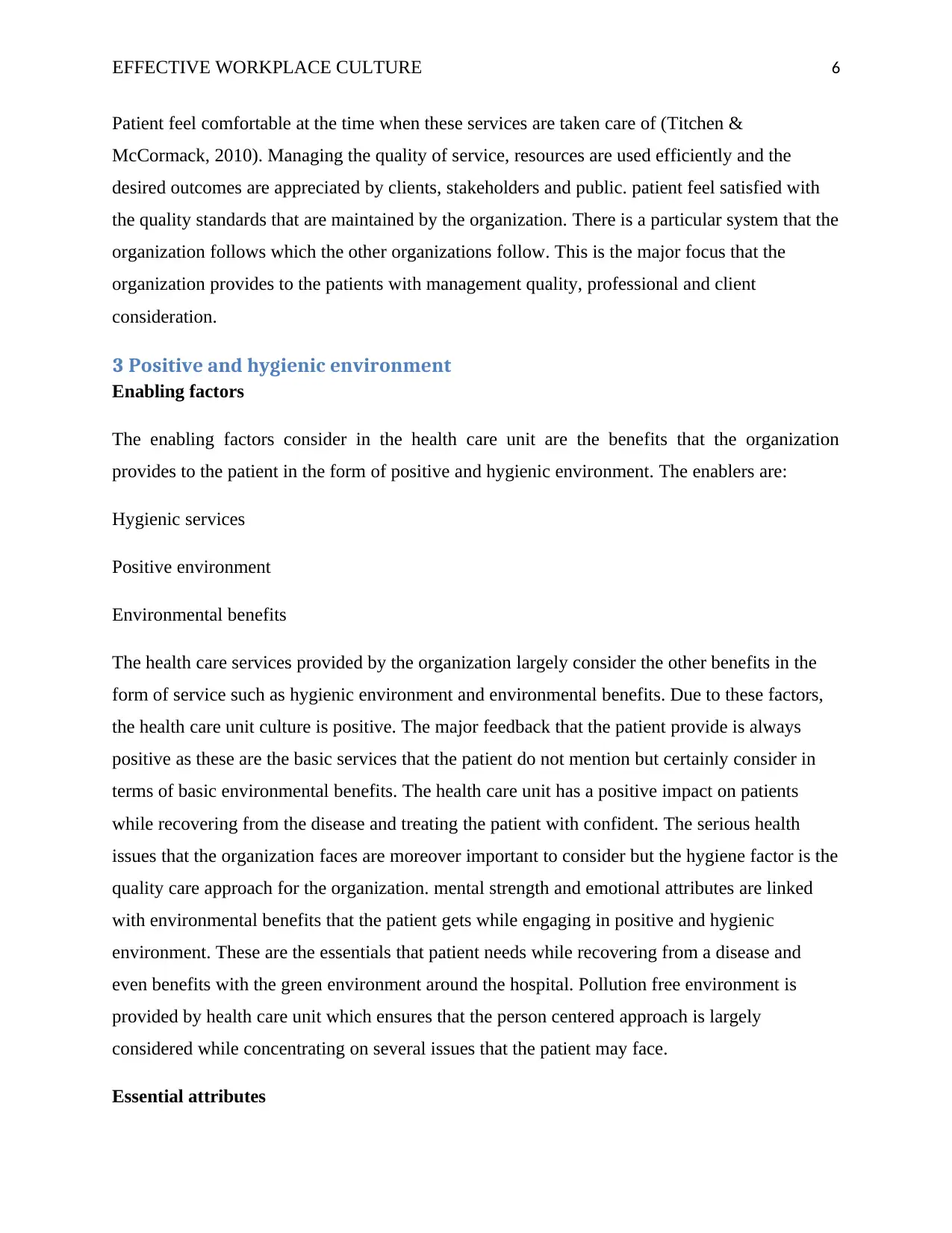
EFFECTIVE WORKPLACE CULTURE 6
Patient feel comfortable at the time when these services are taken care of (Titchen &
McCormack, 2010). Managing the quality of service, resources are used efficiently and the
desired outcomes are appreciated by clients, stakeholders and public. patient feel satisfied with
the quality standards that are maintained by the organization. There is a particular system that the
organization follows which the other organizations follow. This is the major focus that the
organization provides to the patients with management quality, professional and client
consideration.
3 Positive and hygienic environment
Enabling factors
The enabling factors consider in the health care unit are the benefits that the organization
provides to the patient in the form of positive and hygienic environment. The enablers are:
Hygienic services
Positive environment
Environmental benefits
The health care services provided by the organization largely consider the other benefits in the
form of service such as hygienic environment and environmental benefits. Due to these factors,
the health care unit culture is positive. The major feedback that the patient provide is always
positive as these are the basic services that the patient do not mention but certainly consider in
terms of basic environmental benefits. The health care unit has a positive impact on patients
while recovering from the disease and treating the patient with confident. The serious health
issues that the organization faces are moreover important to consider but the hygiene factor is the
quality care approach for the organization. mental strength and emotional attributes are linked
with environmental benefits that the patient gets while engaging in positive and hygienic
environment. These are the essentials that patient needs while recovering from a disease and
even benefits with the green environment around the hospital. Pollution free environment is
provided by health care unit which ensures that the person centered approach is largely
considered while concentrating on several issues that the patient may face.
Essential attributes
Patient feel comfortable at the time when these services are taken care of (Titchen &
McCormack, 2010). Managing the quality of service, resources are used efficiently and the
desired outcomes are appreciated by clients, stakeholders and public. patient feel satisfied with
the quality standards that are maintained by the organization. There is a particular system that the
organization follows which the other organizations follow. This is the major focus that the
organization provides to the patients with management quality, professional and client
consideration.
3 Positive and hygienic environment
Enabling factors
The enabling factors consider in the health care unit are the benefits that the organization
provides to the patient in the form of positive and hygienic environment. The enablers are:
Hygienic services
Positive environment
Environmental benefits
The health care services provided by the organization largely consider the other benefits in the
form of service such as hygienic environment and environmental benefits. Due to these factors,
the health care unit culture is positive. The major feedback that the patient provide is always
positive as these are the basic services that the patient do not mention but certainly consider in
terms of basic environmental benefits. The health care unit has a positive impact on patients
while recovering from the disease and treating the patient with confident. The serious health
issues that the organization faces are moreover important to consider but the hygiene factor is the
quality care approach for the organization. mental strength and emotional attributes are linked
with environmental benefits that the patient gets while engaging in positive and hygienic
environment. These are the essentials that patient needs while recovering from a disease and
even benefits with the green environment around the hospital. Pollution free environment is
provided by health care unit which ensures that the person centered approach is largely
considered while concentrating on several issues that the patient may face.
Essential attributes
⊘ This is a preview!⊘
Do you want full access?
Subscribe today to unlock all pages.

Trusted by 1+ million students worldwide
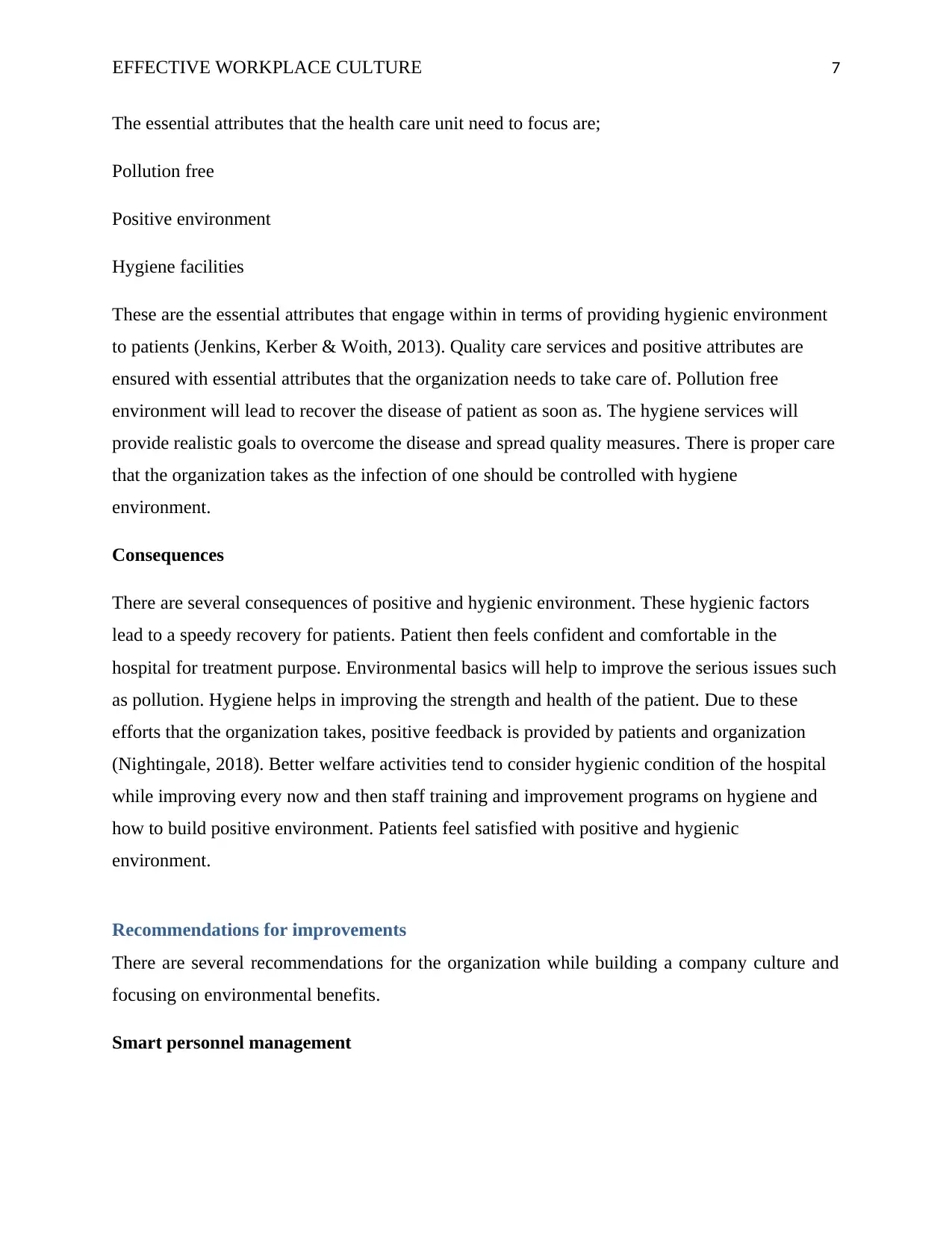
EFFECTIVE WORKPLACE CULTURE 7
The essential attributes that the health care unit need to focus are;
Pollution free
Positive environment
Hygiene facilities
These are the essential attributes that engage within in terms of providing hygienic environment
to patients (Jenkins, Kerber & Woith, 2013). Quality care services and positive attributes are
ensured with essential attributes that the organization needs to take care of. Pollution free
environment will lead to recover the disease of patient as soon as. The hygiene services will
provide realistic goals to overcome the disease and spread quality measures. There is proper care
that the organization takes as the infection of one should be controlled with hygiene
environment.
Consequences
There are several consequences of positive and hygienic environment. These hygienic factors
lead to a speedy recovery for patients. Patient then feels confident and comfortable in the
hospital for treatment purpose. Environmental basics will help to improve the serious issues such
as pollution. Hygiene helps in improving the strength and health of the patient. Due to these
efforts that the organization takes, positive feedback is provided by patients and organization
(Nightingale, 2018). Better welfare activities tend to consider hygienic condition of the hospital
while improving every now and then staff training and improvement programs on hygiene and
how to build positive environment. Patients feel satisfied with positive and hygienic
environment.
Recommendations for improvements
There are several recommendations for the organization while building a company culture and
focusing on environmental benefits.
Smart personnel management
The essential attributes that the health care unit need to focus are;
Pollution free
Positive environment
Hygiene facilities
These are the essential attributes that engage within in terms of providing hygienic environment
to patients (Jenkins, Kerber & Woith, 2013). Quality care services and positive attributes are
ensured with essential attributes that the organization needs to take care of. Pollution free
environment will lead to recover the disease of patient as soon as. The hygiene services will
provide realistic goals to overcome the disease and spread quality measures. There is proper care
that the organization takes as the infection of one should be controlled with hygiene
environment.
Consequences
There are several consequences of positive and hygienic environment. These hygienic factors
lead to a speedy recovery for patients. Patient then feels confident and comfortable in the
hospital for treatment purpose. Environmental basics will help to improve the serious issues such
as pollution. Hygiene helps in improving the strength and health of the patient. Due to these
efforts that the organization takes, positive feedback is provided by patients and organization
(Nightingale, 2018). Better welfare activities tend to consider hygienic condition of the hospital
while improving every now and then staff training and improvement programs on hygiene and
how to build positive environment. Patients feel satisfied with positive and hygienic
environment.
Recommendations for improvements
There are several recommendations for the organization while building a company culture and
focusing on environmental benefits.
Smart personnel management
Paraphrase This Document
Need a fresh take? Get an instant paraphrase of this document with our AI Paraphraser
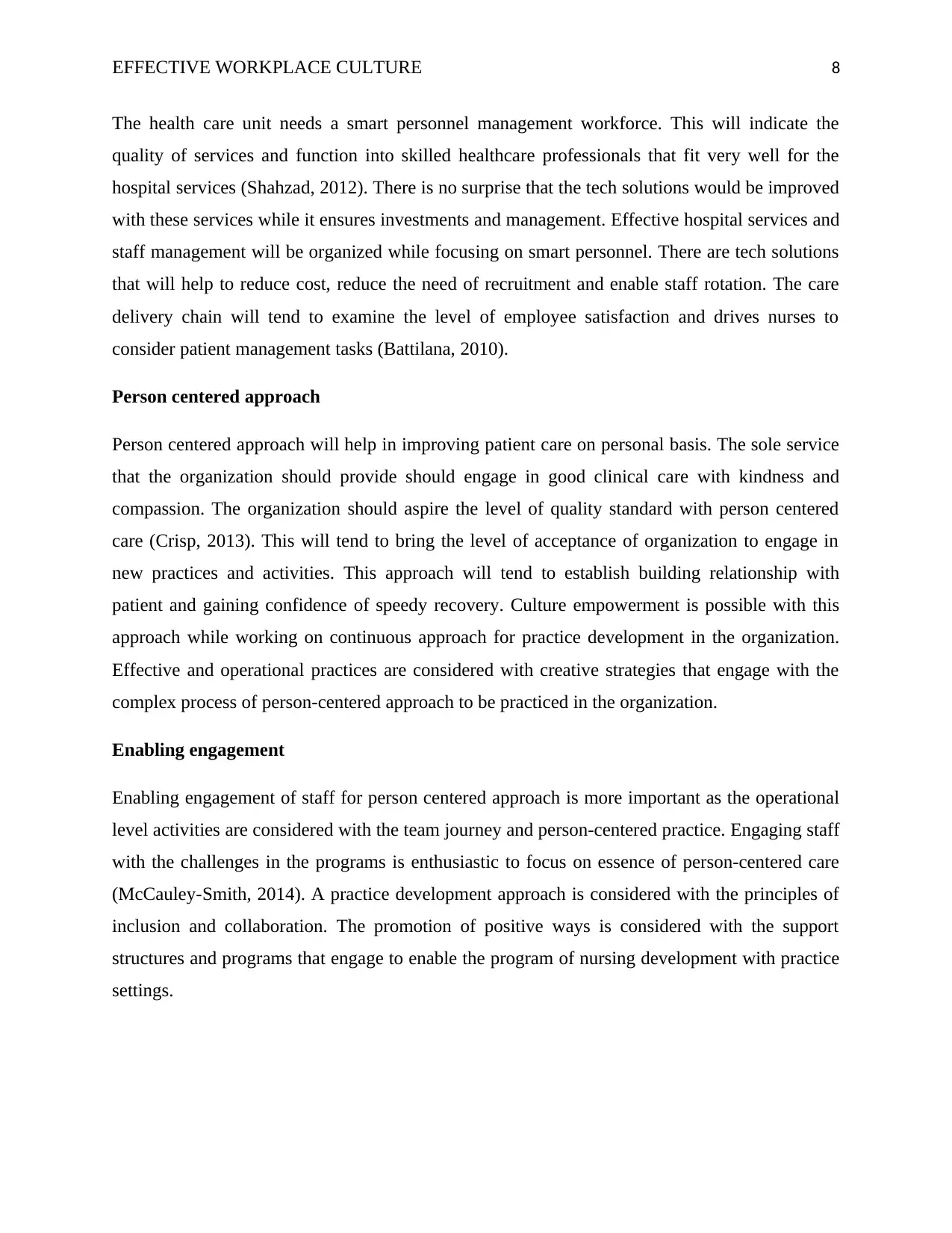
EFFECTIVE WORKPLACE CULTURE 8
The health care unit needs a smart personnel management workforce. This will indicate the
quality of services and function into skilled healthcare professionals that fit very well for the
hospital services (Shahzad, 2012). There is no surprise that the tech solutions would be improved
with these services while it ensures investments and management. Effective hospital services and
staff management will be organized while focusing on smart personnel. There are tech solutions
that will help to reduce cost, reduce the need of recruitment and enable staff rotation. The care
delivery chain will tend to examine the level of employee satisfaction and drives nurses to
consider patient management tasks (Battilana, 2010).
Person centered approach
Person centered approach will help in improving patient care on personal basis. The sole service
that the organization should provide should engage in good clinical care with kindness and
compassion. The organization should aspire the level of quality standard with person centered
care (Crisp, 2013). This will tend to bring the level of acceptance of organization to engage in
new practices and activities. This approach will tend to establish building relationship with
patient and gaining confidence of speedy recovery. Culture empowerment is possible with this
approach while working on continuous approach for practice development in the organization.
Effective and operational practices are considered with creative strategies that engage with the
complex process of person-centered approach to be practiced in the organization.
Enabling engagement
Enabling engagement of staff for person centered approach is more important as the operational
level activities are considered with the team journey and person-centered practice. Engaging staff
with the challenges in the programs is enthusiastic to focus on essence of person-centered care
(McCauley-Smith, 2014). A practice development approach is considered with the principles of
inclusion and collaboration. The promotion of positive ways is considered with the support
structures and programs that engage to enable the program of nursing development with practice
settings.
The health care unit needs a smart personnel management workforce. This will indicate the
quality of services and function into skilled healthcare professionals that fit very well for the
hospital services (Shahzad, 2012). There is no surprise that the tech solutions would be improved
with these services while it ensures investments and management. Effective hospital services and
staff management will be organized while focusing on smart personnel. There are tech solutions
that will help to reduce cost, reduce the need of recruitment and enable staff rotation. The care
delivery chain will tend to examine the level of employee satisfaction and drives nurses to
consider patient management tasks (Battilana, 2010).
Person centered approach
Person centered approach will help in improving patient care on personal basis. The sole service
that the organization should provide should engage in good clinical care with kindness and
compassion. The organization should aspire the level of quality standard with person centered
care (Crisp, 2013). This will tend to bring the level of acceptance of organization to engage in
new practices and activities. This approach will tend to establish building relationship with
patient and gaining confidence of speedy recovery. Culture empowerment is possible with this
approach while working on continuous approach for practice development in the organization.
Effective and operational practices are considered with creative strategies that engage with the
complex process of person-centered approach to be practiced in the organization.
Enabling engagement
Enabling engagement of staff for person centered approach is more important as the operational
level activities are considered with the team journey and person-centered practice. Engaging staff
with the challenges in the programs is enthusiastic to focus on essence of person-centered care
(McCauley-Smith, 2014). A practice development approach is considered with the principles of
inclusion and collaboration. The promotion of positive ways is considered with the support
structures and programs that engage to enable the program of nursing development with practice
settings.
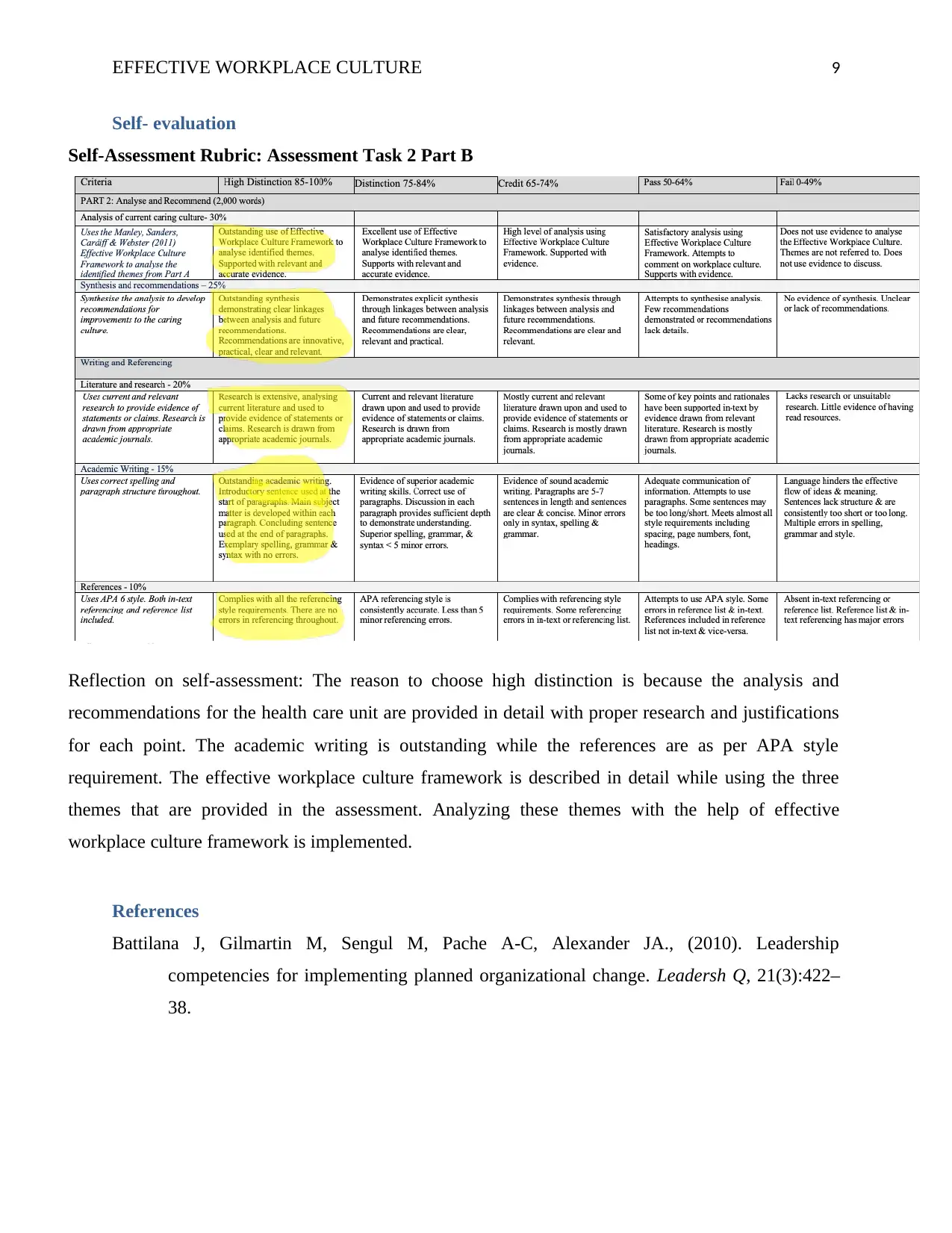
EFFECTIVE WORKPLACE CULTURE 9
Self- evaluation
Self-Assessment Rubric: Assessment Task 2 Part B
Reflection on self-assessment: The reason to choose high distinction is because the analysis and
recommendations for the health care unit are provided in detail with proper research and justifications
for each point. The academic writing is outstanding while the references are as per APA style
requirement. The effective workplace culture framework is described in detail while using the three
themes that are provided in the assessment. Analyzing these themes with the help of effective
workplace culture framework is implemented.
References
Battilana J, Gilmartin M, Sengul M, Pache A-C, Alexander JA., (2010). Leadership
competencies for implementing planned organizational change. Leadersh Q, 21(3):422–
38.
Self- evaluation
Self-Assessment Rubric: Assessment Task 2 Part B
Reflection on self-assessment: The reason to choose high distinction is because the analysis and
recommendations for the health care unit are provided in detail with proper research and justifications
for each point. The academic writing is outstanding while the references are as per APA style
requirement. The effective workplace culture framework is described in detail while using the three
themes that are provided in the assessment. Analyzing these themes with the help of effective
workplace culture framework is implemented.
References
Battilana J, Gilmartin M, Sengul M, Pache A-C, Alexander JA., (2010). Leadership
competencies for implementing planned organizational change. Leadersh Q, 21(3):422–
38.
⊘ This is a preview!⊘
Do you want full access?
Subscribe today to unlock all pages.

Trusted by 1+ million students worldwide
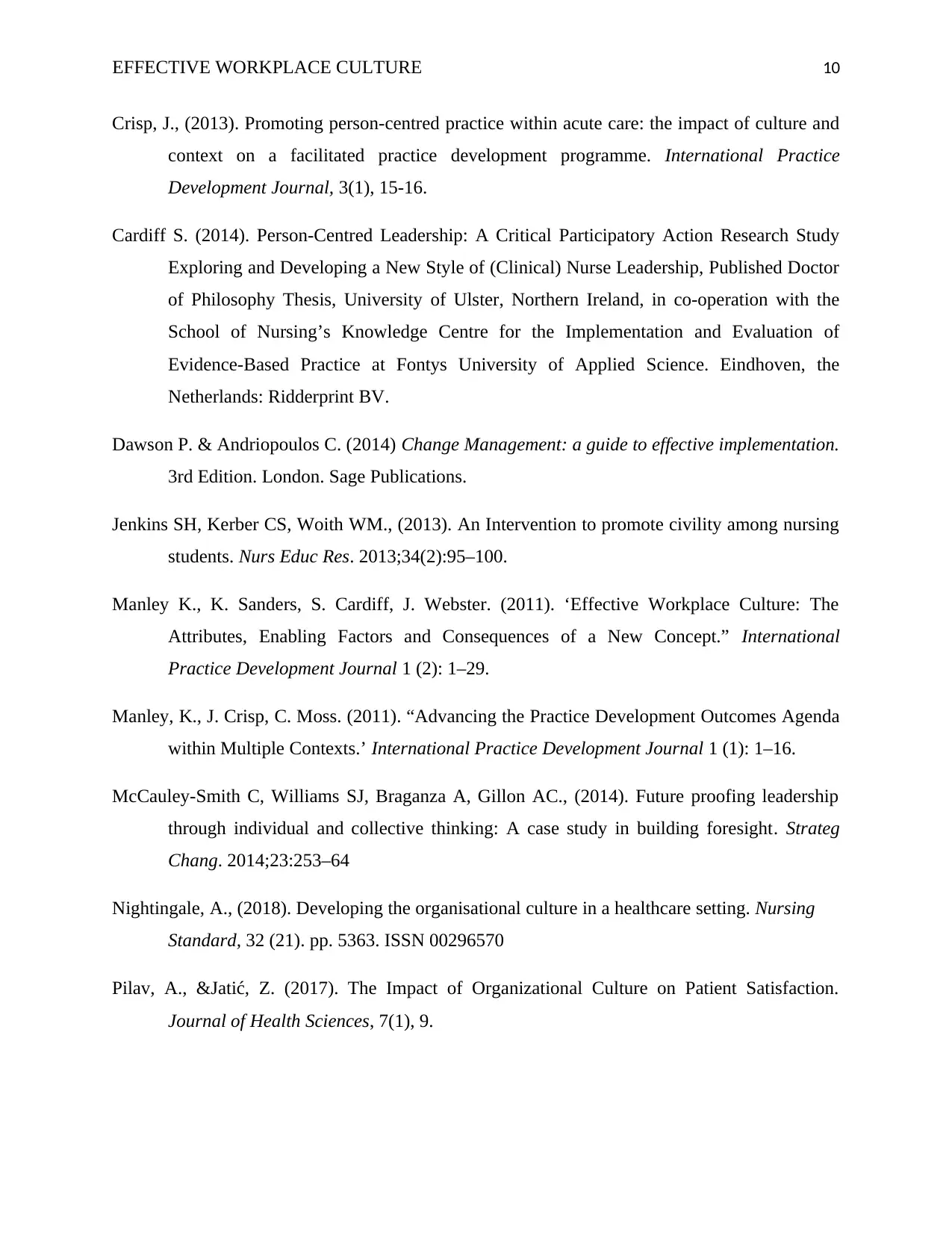
EFFECTIVE WORKPLACE CULTURE 10
Crisp, J., (2013). Promoting person-centred practice within acute care: the impact of culture and
context on a facilitated practice development programme. International Practice
Development Journal, 3(1), 15-16.
Cardiff S. (2014). Person-Centred Leadership: A Critical Participatory Action Research Study
Exploring and Developing a New Style of (Clinical) Nurse Leadership, Published Doctor
of Philosophy Thesis, University of Ulster, Northern Ireland, in co-operation with the
School of Nursing’s Knowledge Centre for the Implementation and Evaluation of
Evidence-Based Practice at Fontys University of Applied Science. Eindhoven, the
Netherlands: Ridderprint BV.
Dawson P. & Andriopoulos C. (2014) Change Management: a guide to effective implementation.
3rd Edition. London. Sage Publications.
Jenkins SH, Kerber CS, Woith WM., (2013). An Intervention to promote civility among nursing
students. Nurs Educ Res. 2013;34(2):95–100.
Manley K., K. Sanders, S. Cardiff, J. Webster. (2011). ‘Effective Workplace Culture: The
Attributes, Enabling Factors and Consequences of a New Concept.” International
Practice Development Journal 1 (2): 1–29.
Manley, K., J. Crisp, C. Moss. (2011). “Advancing the Practice Development Outcomes Agenda
within Multiple Contexts.’ International Practice Development Journal 1 (1): 1–16.
McCauley-Smith C, Williams SJ, Braganza A, Gillon AC., (2014). Future proofing leadership
through individual and collective thinking: A case study in building foresight. Strateg
Chang. 2014;23:253–64
Nightingale, A., (2018). Developing the organisational culture in a healthcare setting. Nursing
Standard, 32 (21). pp. 5363. ISSN 00296570
Pilav, A., &Jatić, Z. (2017). The Impact of Organizational Culture on Patient Satisfaction.
Journal of Health Sciences, 7(1), 9.
Crisp, J., (2013). Promoting person-centred practice within acute care: the impact of culture and
context on a facilitated practice development programme. International Practice
Development Journal, 3(1), 15-16.
Cardiff S. (2014). Person-Centred Leadership: A Critical Participatory Action Research Study
Exploring and Developing a New Style of (Clinical) Nurse Leadership, Published Doctor
of Philosophy Thesis, University of Ulster, Northern Ireland, in co-operation with the
School of Nursing’s Knowledge Centre for the Implementation and Evaluation of
Evidence-Based Practice at Fontys University of Applied Science. Eindhoven, the
Netherlands: Ridderprint BV.
Dawson P. & Andriopoulos C. (2014) Change Management: a guide to effective implementation.
3rd Edition. London. Sage Publications.
Jenkins SH, Kerber CS, Woith WM., (2013). An Intervention to promote civility among nursing
students. Nurs Educ Res. 2013;34(2):95–100.
Manley K., K. Sanders, S. Cardiff, J. Webster. (2011). ‘Effective Workplace Culture: The
Attributes, Enabling Factors and Consequences of a New Concept.” International
Practice Development Journal 1 (2): 1–29.
Manley, K., J. Crisp, C. Moss. (2011). “Advancing the Practice Development Outcomes Agenda
within Multiple Contexts.’ International Practice Development Journal 1 (1): 1–16.
McCauley-Smith C, Williams SJ, Braganza A, Gillon AC., (2014). Future proofing leadership
through individual and collective thinking: A case study in building foresight. Strateg
Chang. 2014;23:253–64
Nightingale, A., (2018). Developing the organisational culture in a healthcare setting. Nursing
Standard, 32 (21). pp. 5363. ISSN 00296570
Pilav, A., &Jatić, Z. (2017). The Impact of Organizational Culture on Patient Satisfaction.
Journal of Health Sciences, 7(1), 9.
Paraphrase This Document
Need a fresh take? Get an instant paraphrase of this document with our AI Paraphraser
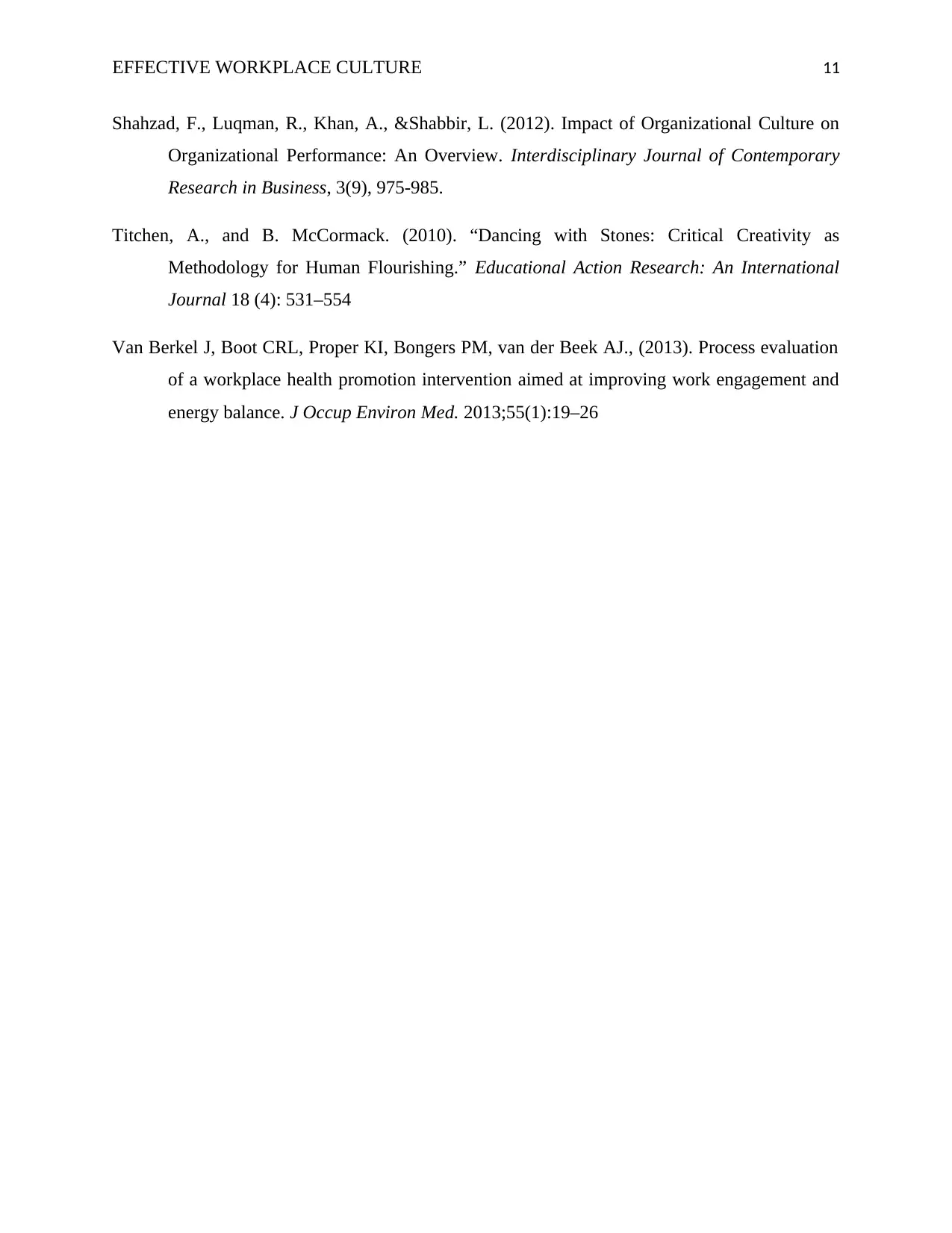
EFFECTIVE WORKPLACE CULTURE 11
Shahzad, F., Luqman, R., Khan, A., &Shabbir, L. (2012). Impact of Organizational Culture on
Organizational Performance: An Overview. Interdisciplinary Journal of Contemporary
Research in Business, 3(9), 975-985.
Titchen, A., and B. McCormack. (2010). “Dancing with Stones: Critical Creativity as
Methodology for Human Flourishing.” Educational Action Research: An International
Journal 18 (4): 531–554
Van Berkel J, Boot CRL, Proper KI, Bongers PM, van der Beek AJ., (2013). Process evaluation
of a workplace health promotion intervention aimed at improving work engagement and
energy balance. J Occup Environ Med. 2013;55(1):19–26
Shahzad, F., Luqman, R., Khan, A., &Shabbir, L. (2012). Impact of Organizational Culture on
Organizational Performance: An Overview. Interdisciplinary Journal of Contemporary
Research in Business, 3(9), 975-985.
Titchen, A., and B. McCormack. (2010). “Dancing with Stones: Critical Creativity as
Methodology for Human Flourishing.” Educational Action Research: An International
Journal 18 (4): 531–554
Van Berkel J, Boot CRL, Proper KI, Bongers PM, van der Beek AJ., (2013). Process evaluation
of a workplace health promotion intervention aimed at improving work engagement and
energy balance. J Occup Environ Med. 2013;55(1):19–26
1 out of 11
Related Documents
Your All-in-One AI-Powered Toolkit for Academic Success.
+13062052269
info@desklib.com
Available 24*7 on WhatsApp / Email
![[object Object]](/_next/static/media/star-bottom.7253800d.svg)
Unlock your academic potential
Copyright © 2020–2025 A2Z Services. All Rights Reserved. Developed and managed by ZUCOL.





